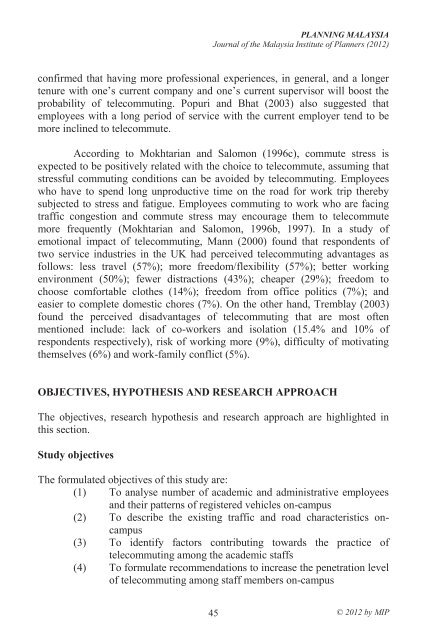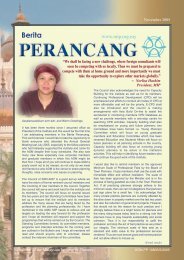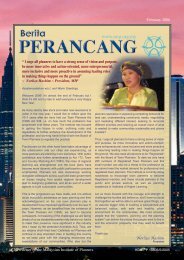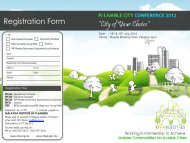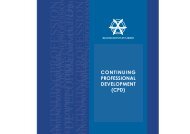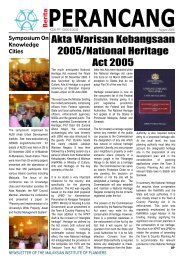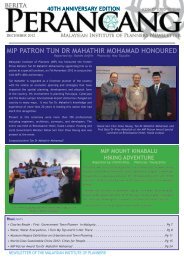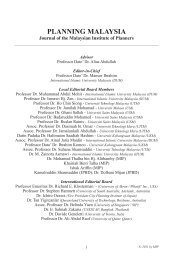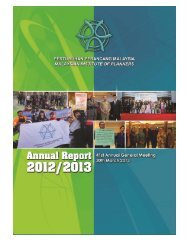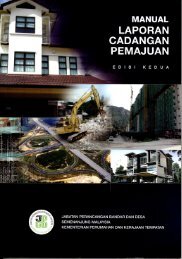Farah Diyanah Ismail, Abdul Azeez Kadar Hamsa & Mansor IbrahimAnalysis <strong>of</strong> Factors Influencing the Stated Preference <strong>of</strong> Academic Employees Towards Telecommutingin IIUM Campus, GombakThe literature on telecommuting has grown significantly, especially inwestern countries, over the last two decades. Research on telecommuting indeveloping countries is still considered unsurprisingly new (Mohamed andAbdallah, 2009). On empirical part <strong>of</strong> telecommuting research, someresearchers had presented results from the investigation and analyze <strong>of</strong> thepreference towards performing telecommuting among the employees. WanRozaini and Haitham (2005), for example, had used a sample <strong>of</strong> 70 lecturersfrom “Fakulti Teknologi Maklumat (faculty <strong>of</strong> information technology)” toinvestigate the possibilities <strong>of</strong> implementing telecommuting as a first mode <strong>of</strong>working at all faculties at Universiti Utara Malaysia (one <strong>of</strong> the publicUniversities) by ascertaining their views on willingness to telecommute.Similarly, Abdul Azeez and Wan Nurul Mardiah (2009) had conducted a studyto unravel travel, work and socioeconomic characteristics <strong>of</strong> the stated preferredtelecommuters and factors associated with preference to telecommute in theprivate and public sectors in Johor Bahru and Kuala Lumpur city by targeting391 employees.Based on earlier studies, Yen and Mahmassani (1994), Sullivan (1993)and Peters et al. (2004) had agreed that the decision to telecommute is governedby socioeconomic variables. In terms <strong>of</strong> gender, Popuri and Bhat (2003), Yapand Tng (1990) and Wells et al. (2001) had suggested that telecommutingwould be <strong>of</strong> particular interest to women employees. Earlier studies hadidentified that age is also one <strong>of</strong> the factors that contribute to preference toadopt telecommuting (Mokhtarian and Meenakshisundaram, 2002 and Walls etal., 2007). Thériault et al., (2005) had suggested that older workers are morelikely to telecommute than younger ones. Several studies have suggested thattelecommuting would be <strong>of</strong> particular interest to employees who have children(Popuri and Bhat, 2003; Yap and Tng, 1990 and Wells et al., 2001).Furthermore, Peters et al. (2004) had assumed that the likelihood on thepreference to telecommute is positively influenced by the number <strong>of</strong> childrenespecially children in the youngest age group. The employees with a child underthe age <strong>of</strong> four more <strong>of</strong>ten prefer to telecommute than employees with a childover 12 years <strong>of</strong> age. On other aspects, Walls et al. (2007) claimed that both thechoice and frequency decisions <strong>of</strong> telecommuting were found to be substantialinfluences <strong>of</strong> workplace-related factors. According to Brown (2010), jobposition plays an important role in the selection process or in some nontelecommuters’decision to opt out <strong>of</strong> telecommuting. Moreover, the length <strong>of</strong>service also found to be one <strong>of</strong> the important influential factors for the decisionto telecommute (Bagley and Mokhtarian, 1997). Safirova and Walls (2004)© 2012 by MIP 44
PLANNING MALAYSIAJournal <strong>of</strong> the Malaysia <strong>Institute</strong> <strong>of</strong> <strong>Planners</strong> (2012)confirmed that having more pr<strong>of</strong>essional experiences, in general, and a longertenure with one’s current company and one’s current supervisor will boost theprobability <strong>of</strong> telecommuting. Popuri and Bhat (2003) also suggested thatemployees with a long period <strong>of</strong> service with the current employer tend to bemore inclined to telecommute.According to Mokhtarian and Salomon (1996c), commute stress isexpected to be positively related with the choice to telecommute, assuming thatstressful commuting conditions can be avoided by telecommuting. Employeeswho have to spend long unproductive time on the road for work trip therebysubjected to stress and fatigue. Employees commuting to work who are facingtraffic congestion and commute stress may encourage them to telecommutemore frequently (Mokhtarian and Salomon, 1996b, 1997). In a study <strong>of</strong>emotional impact <strong>of</strong> telecommuting, Mann (2000) found that respondents <strong>of</strong>two service industries in the UK had perceived telecommuting advantages asfollows: less travel (57%); more freedom/flexibility (57%); better workingenvironment (50%); fewer distractions (43%); cheaper (29%); freedom tochoose comfortable clothes (14%); freedom from <strong>of</strong>fice politics (7%); andeasier to complete domestic chores (7%). On the other hand, Tremblay (2003)found the perceived disadvantages <strong>of</strong> telecommuting that are most <strong>of</strong>tenmentioned include: lack <strong>of</strong> co-workers and isolation (15.4% and 10% <strong>of</strong>respondents respectively), risk <strong>of</strong> working more (9%), difficulty <strong>of</strong> motivatingthemselves (6%) and work-family conflict (5%).OBJECTIVES, HYPOTHESIS AND RESEARCH APPROACHThe objectives, research hypothesis and research approach are highlighted inthis section.Study objectivesThe formulated objectives <strong>of</strong> this study are:(1) To analyse number <strong>of</strong> academic and administrative employeesand their patterns <strong>of</strong> registered vehicles on-campus(2) To describe the existing traffic and road characteristics oncampus(3) To identify factors contributing towards the practice <strong>of</strong>telecommuting among the academic staffs(4) To formulate recommendations to increase the penetration level<strong>of</strong> telecommuting among staff members on-campus45© 2012 by MIP


